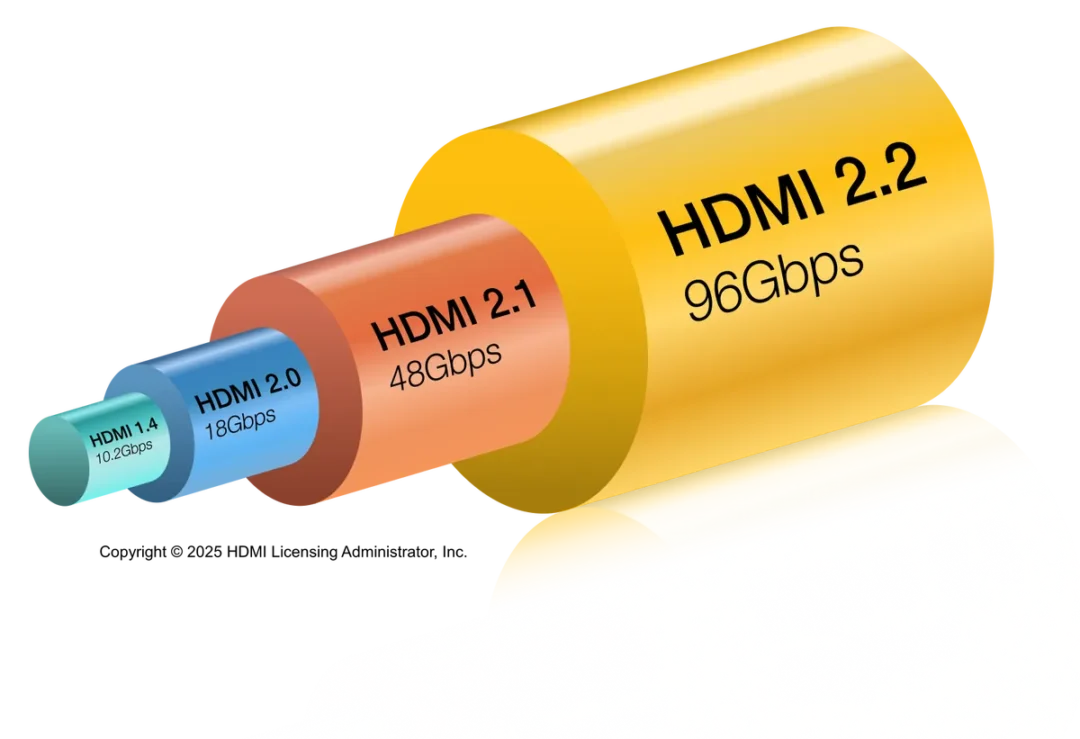The HDMI Forum officially released Version 2.2 of the HDMI Specification on June 25, 2025 HDMI Forum, marking the most significant upgrade to HDMI technology since HDMI 2.1 launched eight years ago. For corporate AV integrators and facilities managers planning technology investments, understanding HDMI 2.2's capabilities isn't just about staying current—it's about future-proofing installations and making informed decisions about when to adopt this new standard.
The defining feature is the doubling of bandwidth from 48Gbps to 96Gbps HDMIHDMI Forum, enabling uncompressed video at resolutions and refresh rates that were previously impossible. This isn't incremental improvement—it's a fundamental expansion of what's technically possible in professional AV applications.
The standard supports resolutions up to 12K at 120Hz and 16K at 60Hz HDMI Forum, though more immediately relevant for corporate applications are the uncompressed formats: 8K at 60Hz with full 4:4:4 chroma and 4K at 240Hz with full 4:4:4 chroma, both at 10-bit and 12-bit color depth HDMI Forum.

To achieve these bandwidth levels, HDMI 2.2 requires new Ultra96 certified cables. These cables support up to 96Gbps and are part of the HDMI Cable Certification Program, requiring each model length to be tested and certified with a Certification Label HDMI Forum.
Here's what matters for installations: the Ultra96 cables are backward compatible with existing HDMI equipment, but you won't see the benefits of HDMI 2.2 until both ends of the connection support the new standard. Ultra96 cables are expected to reach the market in Q3/Q4 2025 HDMI.
The good news? The current Ultra High Speed HDMI Cable remains applicable for system configurations supporting up to 48Gbps maximum bandwidth HDMI Forum, so your HDMI 2.1 infrastructure doesn't become obsolete overnight.
One of HDMI 2.2's most practical innovations is the Latency Indication Protocol. LIP improves audio and video synchronization, especially for multiple-hop system configurations such as those with an audio video receiver or soundbar HDMI Forum.
Anyone who's dealt with persistent lip-sync issues in conference rooms with complex audio routing knows how frustrating these problems can be. LIP provides a standardized method for devices to communicate latency information throughout the signal chain, enabling automatic compensation. This addresses a long-standing pain point in corporate AV installations where audio may be processed through DSPs, conference systems, or distributed audio infrastructure.
For most conference room applications in 2025-2026, HDMI 2.2 is overkill. Standard corporate video conferencing maxes out at 4K/30fps, well within HDMI 2.1's capabilities. However, the LIP feature could be valuable for installations with complex audio routing—think large boardrooms with ceiling mic arrays, distributed speakers, and video conferencing integration.
HDMI 2.2's higher resolution and color bit depth ensure greater detail for large digital signage and displays, as well as massive video walls for stadiums, shopping complexes, and similar venues AVNetwork. For corporate lobbies, operations centers, and command-and-control applications running native 8K content or ultra-high-refresh-rate displays, HDMI 2.2 becomes relevant sooner.
This is where HDMI 2.2 becomes immediately relevant. The faster 96Gbps bandwidth improves demanding data-intensive, immersive and virtual applications such as AR/VR/MR, spatial reality and light field displays HDMI.
For corporate clients investing in virtual production facilities, XR stages, or immersive training environments, HDMI 2.2 enables uncompressed high-refresh-rate content that's critical for camera tracking and real-time rendering applications. The ability to handle 4K at 240Hz or higher with full chroma and deep color makes a tangible difference in motion blur reduction and visual fidelity.
Commercial applications such as medical imaging and machine vision HDMI benefit from the increased bandwidth and color accuracy. Healthcare facilities planning diagnostic imaging suites or telemedicine centers should consider HDMI 2.2 for future display technology compatibility.
Market-wide adoption is expected to grow steadily over the next three to five years AVNetwork. While the specification is available now, the ecosystem of compatible devices needs time to develop.
Late 2025: First consumer and professional displays with HDMI 2.2 input support appear on the market. Ultra96 cables become available. Early adopters in gaming and home theater markets drive initial production.
2026: Professional display manufacturers begin incorporating HDMI 2.2 into flagship models. Media players, presentation systems, and graphics cards with HDMI 2.2 output become available. Most corporate AV installations will still use HDMI 2.1 infrastructure.
2027-2028: HDMI 2.2 becomes standard in mid-to-high-end professional displays and source equipment. This is when specifying HDMI 2.2 in corporate installations becomes practical and cost-effective.
2029-2030: HDMI 2.2 achieves market dominance in professional AV products, similar to how HDMI 2.1 is standard today.
For Projects Starting Now Through 2026:
For Long-Term Planning:
Cable Management Strategy:
HDMI 2.2 represents genuine technological advancement, not marketing hype. The doubled bandwidth, improved sync capabilities, and support for next-generation display technologies create meaningful benefits for specific applications.
However, the practical impact for most corporate AV installations remains limited until the ecosystem matures. Standard conference rooms, training facilities, and collaboration spaces won't see operational benefits from HDMI 2.2 for several years. The technology's value appears first in specialized applications: virtual production, immersive training environments, high-refresh esports facilities, and installations where the Latency Indication Protocol solves persistent audio-video sync issues.
The smart approach? Understand the technology, plan infrastructure with future capacity in mind, but don't rush adoption until compatible devices become available at reasonable costs and your specific applications benefit from the enhanced capabilities. HDMI 2.2 is the future of professional AV connectivity—but for most corporate installations, that future arrives in 2027-2028, not 2025.
